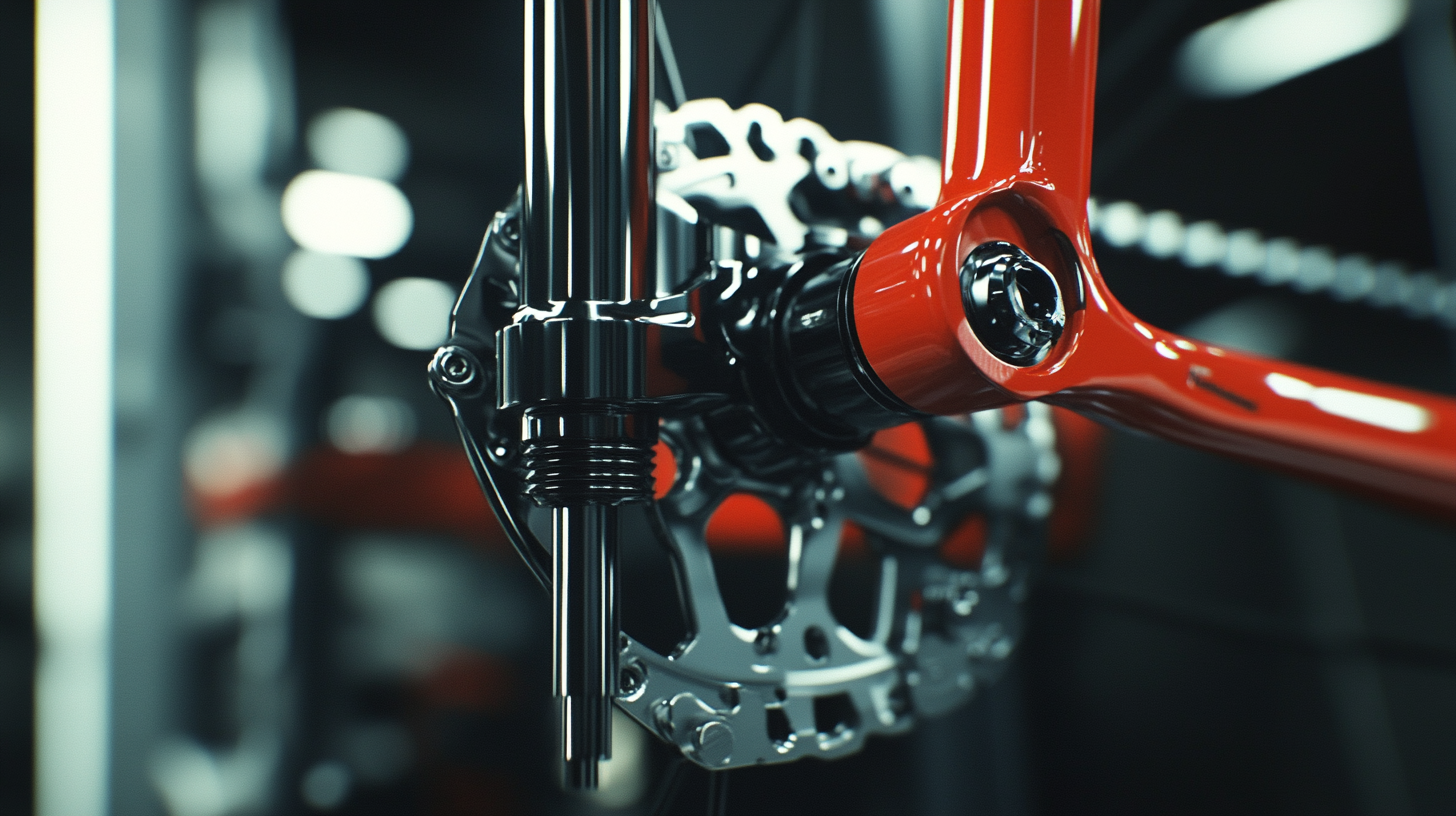The evolution of bicycle fork manufacturing standards has significantly influenced both the performance and safety of cycling. According to the National Bicycle Dealers Association, the global bicycle market is projected to reach $70 billion by 2025, highlighting the critical importance of advancements in bicycle components, particularly the bicycle fork.

Historically, the materials and design of bicycle forks have undergone substantial transformations, shifting from traditional steel constructions to innovative carbon fiber and aluminum options. Reports from the International Association of Cycling Experts indicate that modern bicycle forks enhance aerodynamics and shock absorption, allowing for improved rider control and comfort.
As cyclists demand higher performance, understanding the technical standards governing bicycle fork design and manufacture is essential not only for enthusiasts but also for manufacturers aiming to stay competitive in an evolving marketplace. This blog will explore these standards and their profound impact on cycling performance.
The evolution of bicycle fork technology has dramatically transformed the cycling experience, pivoting from rudimentary designs to highly specialized equipment. Historically, the first forks were crafted from wood, primarily focusing on basic functionality and structural strength. However, as cycling gained popularity in the late 19th century, the demand for enhanced performance led to the introduction of materials like steel and aluminum, which offered increased durability and reduced weight. According to a 2019 report from the Bicycle Product Suppliers Association, the market for advanced bicycle components, including forks, grew by 6% annually, reflecting the industry's shift towards higher standards and performance-focused manufacturing.
In recent years, the emergence of carbon fiber as a prevailing material has further revolutionized fork design. Carbon fiber forks provide substantial advantages in terms of stiffness while significantly lowering weight, thus improving overall bike performance. A study published by the International Journal of Sports Engineering indicated that optimizing fork geometry, combined with advancements in materials, can lead to performance enhancements of up to 15% in racing conditions. The implementation of standardized testing protocols has also ensured that forks meet safety and performance benchmarks, resulting in greater consumer confidence and enhanced riding experiences across various cycling disciplines.
The bicycle fork manufacturing industry has undergone significant transformations driven by key manufacturers and innovations. Companies such as RockShox and Fox Racing Shox have pioneered advancements in suspension technology, contributing to enhanced performance and rider experience. According to a 2022 industry report by MarketsandMarkets, the global bicycle components market, which includes forks, is projected to grow at a CAGR of 5.6% over the next five years, underscoring the increasing emphasis on high-quality materials and design.
One of the most notable developments is the integration of carbon fiber materials into fork design. Leading manufacturers like Shimano have embraced this lightweight option, resulting in forks that not only reduce overall bike weight but also improve stiffness and responsiveness. The same report highlights that 65% of high-end bicycles are now equipped with carbon forks, reflecting a shift in consumer preferences toward performance enhancements.
Tips: When selecting a bicycle, consider the type of fork that best suits your riding style. For off-road biking, a sturdy suspension fork is essential to absorb shocks, while road cyclists may benefit more from a rigid fork for efficiency. Additionally, keep an eye on innovations from top manufacturers; they often set industry standards that can influence your purchasing decisions.
This chart illustrates the advancements in bicycle fork manufacturing standards over the years, highlighting key innovations and their impacts on performance metrics such as weight, stiffness, and aerodynamics.
 The evolution of bicycle fork manufacturing standards has significant implications for rider safety and performance metrics. Over the years, advancements in materials and technology, such as the transition from steel to lightweight carbon fiber, have enhanced both strength and weight efficiency. According to industry reports, forks made from high-modulus carbon can save up to 300 grams without compromising structural integrity, which improves handling and acceleration. However, adherence to updated standards is crucial, as improperly engineered forks can lead to catastrophic failures during high-stress rides.
The evolution of bicycle fork manufacturing standards has significant implications for rider safety and performance metrics. Over the years, advancements in materials and technology, such as the transition from steel to lightweight carbon fiber, have enhanced both strength and weight efficiency. According to industry reports, forks made from high-modulus carbon can save up to 300 grams without compromising structural integrity, which improves handling and acceleration. However, adherence to updated standards is crucial, as improperly engineered forks can lead to catastrophic failures during high-stress rides.
Tips: When selecting a bike, ensure that the fork's specifications meet the latest ISO and CEN standards. This not only contributes to overall safety but maximizes performance potential. Regular maintenance checks can also prevent wear and tear, prolonging the lifespan of the forks and enhancing rider safety.
Furthermore, rider performance metrics can be significantly impacted by the fork design. For instance, forks with increased stiffness have shown to enhance power transfer, leading to faster speeds—an essential factor for competitive cyclists. A study indicated that riders using stiffer forks can experience a 10% increase in energy efficiency, which is critical during endurance races.
Tips: Consider performance-focused fork upgrades, especially for competitive cycling. Evaluate your riding style and preference, as the right fork can dramatically influence speed and control.
As the cycling industry evolves, the focus on sustainable materials and innovative manufacturing processes has never been more crucial. Recent advancements in bicycle fork manufacturing are leading to the incorporation of eco-friendly materials such as recycled aluminum and bio-resins, which not only reduce environmental impact but also enhance performance. These materials offer a unique combination of lightweight functionality and exceptional durability, ensuring that cyclists can enjoy superior handling while minimizing their carbon footprint.
Looking ahead, trends in bicycle fork design are increasingly steering towards modular components that can be easily upgraded or replaced. This shift not only promotes sustainability by extending the lifecycle of bicycle forks but also allows for customization to meet the diverse needs of cyclists. Furthermore, advancements in additive manufacturing and 3D printing are revolutionizing the way fork components are produced, allowing for greater design flexibility and reduced waste. As these trends solidify, the bicycle industry can anticipate a future where innovation, performance, and sustainability go hand in hand, paving the way for a greener and more efficient cycling experience.
| Year | Material | Weight (g) | Strength (N/mm²) | Sustainability Rating |
|---|---|---|---|---|
| 2000 | Steel | 900 | 250 | Low |
| 2010 | Aluminum | 700 | 300 | Medium |
| 2020 | Carbon Fiber | 500 | 800 | High |
| 2023 | Titanium | 600 | 900 | Very High |
The bicycle fork sector is poised for significant growth as we approach 2025, driven by innovative manufacturing standards and shifting consumer preferences. As performance standards evolve, manufacturers are adopting new materials and technologies that enhance ride quality and safety. However, the sector also faces challenges such as maintaining production efficiency amid rising costs and supply chain disruptions.
Tips for manufacturers: Focus on integrating advanced materials that can improve weight-to-strength ratios. This not only enhances performance but also appeals to a growing market segment interested in high-quality, durable products. Additionally, investing in sustainable manufacturing practices can attract environmentally conscious consumers who are increasingly prioritizing eco-friendly options in their purchasing decisions.
Moreover, staying attuned to market trends is crucial. Regularly engage with customer feedback to adapt products to align with their expectations and preferences. Be proactive in exploring partnerships with tech firms to incorporate smart features into bicycle forks, such as adjustable dampening systems. This innovation could set brands apart in a competitive market and tap into the potential for upward growth in the coming years.

